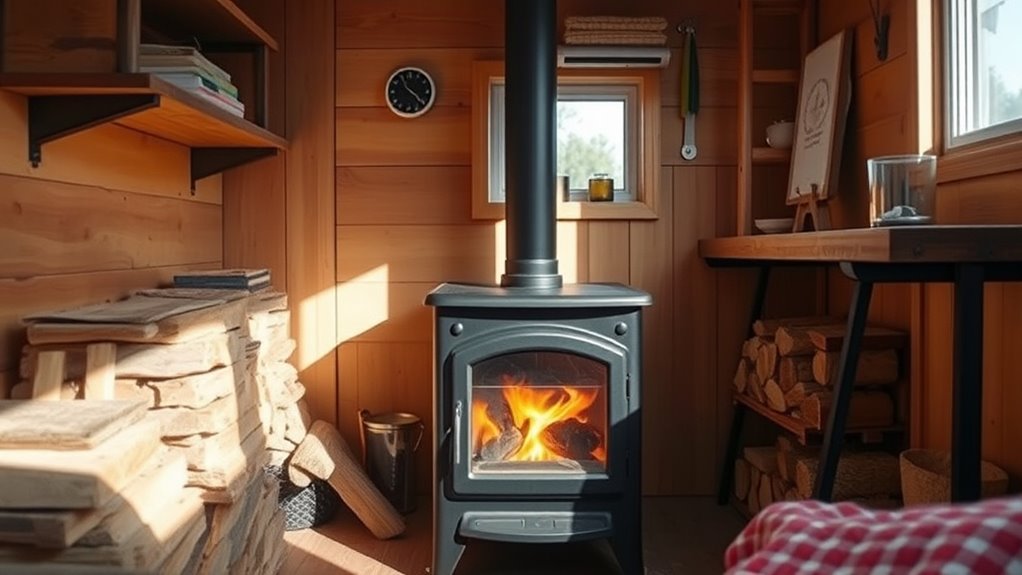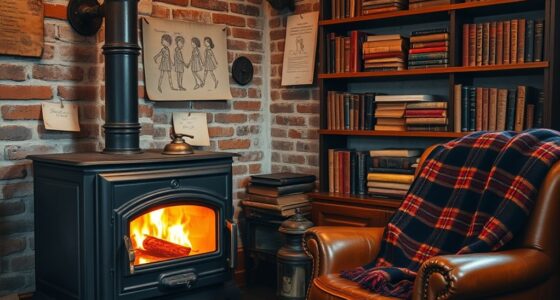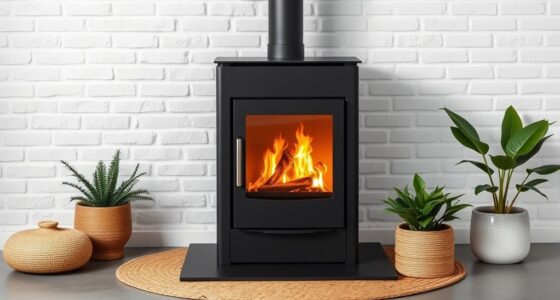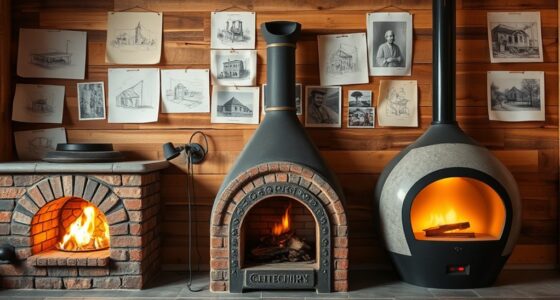Wood stoves are becoming increasingly popular in tiny homes and van life because they offer affordable, sustainable heat that works off-grid. They’re easy to install on fireproof surfaces, burn seasoned wood, and keep your space cozy without relying on electricity or gas. Proper safety and maintenance are key for safe, efficient use. If you want to discover more on how to safely and effectively incorporate a wood stove into your tiny living space, keep exploring.
Key Takeaways
- Increasing popularity due to their sustainability, cost-effectiveness, and off-grid heating capabilities in tiny homes and vans.
- Growing awareness of safety and proper installation practices to mitigate fire and health risks.
- Adoption driven by desire for cozy, efficient heating without reliance on traditional power sources.
- Advances in compact, efficient wood stove designs tailored for small, mobile living spaces.
- Emphasis on maintenance and ventilation to ensure safe, long-lasting operation in limited environments.
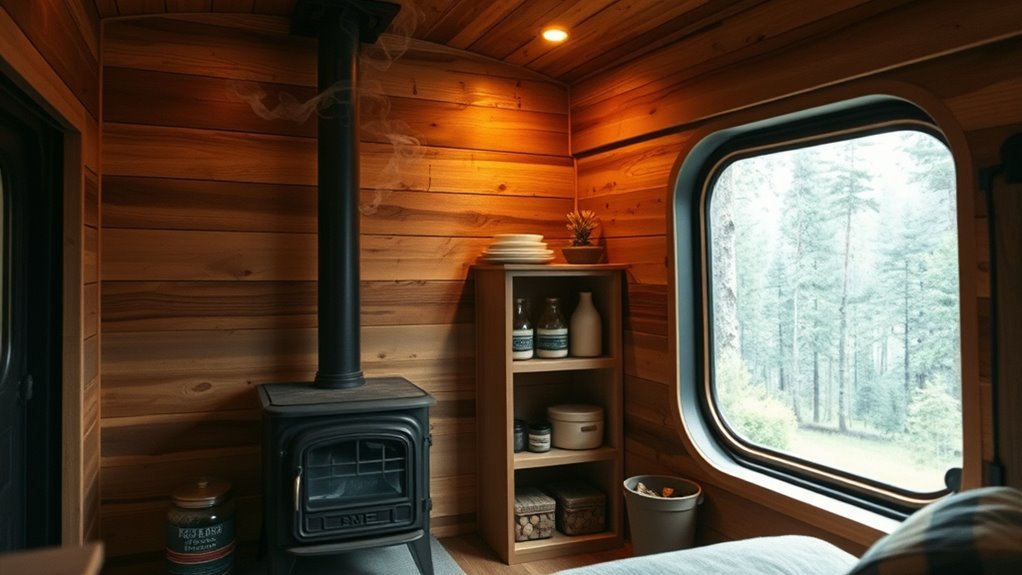
As more people embrace tiny homes and van life, wood stoves have become a popular choice for heating. They offer a cozy, efficient way to stay warm, especially in off-grid situations where traditional heating sources might not be available. Many enthusiasts choose wood stoves because they provide sustainable heating options, reducing reliance on electricity or gas. Burning wood is renewable, and if you source your fuel responsibly, it’s an eco-friendly way to keep your space comfortable. Plus, wood stoves can be a cost-effective solution over time, since wood is often less expensive than other fuel sources and readily accessible in many areas.
Wood stoves offer sustainable, cost-effective heating for tiny homes and van life.
However, adopting a wood stove in a tiny home or van requires careful attention to safety precautions. These stoves generate serious heat, and improper installation or usage can lead to fire hazards or carbon monoxide poisoning. To guarantee safety, you need to install your wood stove on a non-combustible surface and maintain a safe clearance from walls, furniture, and other flammable materials. Ventilation is critical; a properly installed chimney or flue system must direct smoke outside efficiently, preventing dangerous indoor buildup. Regular cleaning of the chimney is essential to prevent creosote buildup, which can cause fires. You should also install carbon monoxide and smoke detectors, testing them frequently to ensure they’re working correctly.
When using your wood stove, always use seasoned, dry wood that burns cleanly and produces less creosote. Never burn trash, treated wood, or other materials that may release toxic fumes. Keep a fire extinguisher nearby, and ensure everyone in your tiny home or van knows how to use it. It’s also wise to have a fireproof mat or barrier underneath the stove to catch any stray embers or ashes. Ventilation isn’t just about installing a chimney; you should also ensure proper airflow within your space to prevent indoor air pollution and maintain good air quality. Additionally, understanding the ventilation considerations is crucial for safe and efficient operation.
In addition to safety, you should plan for regular maintenance and inspections. Check seals, gaskets, and the chimney for wear or blockages. Staying vigilant with safety precautions not only protects you but also maximizes the functional efficiency of your wood stove. Incorporating proper installation techniques can significantly enhance safety and efficiency, ensuring your heating setup is reliable. Regularly reviewing sound design principles for your heating system can help identify areas for improvement and prevent potential hazards. By following these guidelines, you can enjoy sustainable heating with your wood stove, creating a warm, cozy environment in your tiny home or van while minimizing risks. With proper care, a wood stove can be a reliable, eco-friendly heating solution that enhances your off-grid lifestyle.
Frequently Asked Questions
How Do Wood Stoves Impact Tiny Home Resale Value?
Wood stoves can boost your tiny home’s resale value by enhancing its market appeal, especially for buyers who value cozy, off-grid living. They demonstrate energy efficiency and a unique charm that many buyers find attractive. However, guarantee proper installation and safety compliance, as poorly installed stoves might deter potential buyers. Overall, a well-maintained wood stove can make your tiny home more desirable and increase its resale value.
What Are the Insurance Considerations for Wood Stoves?
A tiny home’s safety depends on your insurance considerations, especially with a wood stove. You should check insurance requirements to guarantee proper liability coverage, as fire risks can be catastrophic. Many insurers demand certified installations and regular inspections to minimize hazards. Failing to meet these standards could leave you vulnerable to hefty out-of-pocket costs if an incident occurs. Always verify your policy details to keep your cozy home protected from unexpected disasters.
Are Wood Stoves Suitable for All Climates and Seasons?
Wood stoves aren’t suitable for all climates and seasons. In colder regions, they provide excellent climate adaptability and seasonal comfort, keeping your space warm even in harsh winters. However, in milder or hot climates, they can make your home uncomfortably warm or require extra ventilation. Consider your local weather patterns and insulation needs to determine if a wood stove enhances your comfort year-round or if alternative heating options suit better.
How Do I Prevent Carbon Monoxide Buildup in Small Spaces?
To prevent carbon monoxide buildup in small spaces, you should guarantee proper ventilation strategies by installing vents or open windows while using your wood stove. Always use a high-quality carbon monoxide detector and check it regularly to alert you of any dangerous levels. Never leave the stove unattended for long periods, and keep the flue or chimney clean to ensure proper exhaust. These steps keep your space safe and CO-free.
What Maintenance Is Required for Long-Term Safety and Efficiency?
You might worry about safety and efficiency over time, but regular maintenance keeps your stove running smoothly. You should schedule chimney inspections annually to prevent blockages, and always dispose of ash properly to avoid buildup. Keep the stove clean, check for corrosion, and guarantee proper venting. These simple steps protect you from dangerous carbon monoxide leaks and ensure your stove stays safe and efficient for years to come.
Conclusion
As you consider the charm of tiny homes and van life, the popularity of wood stoves offers cozy warmth and independence. They’re eco-friendly and cost-effective, making them a smart choice for minimalist living. But before jumping in, ask yourself: is embracing this rustic heat source truly the best fit for your lifestyle? With careful planning, a wood stove can transform your space into a warm, inviting retreat—are you ready to make that cozy leap?

